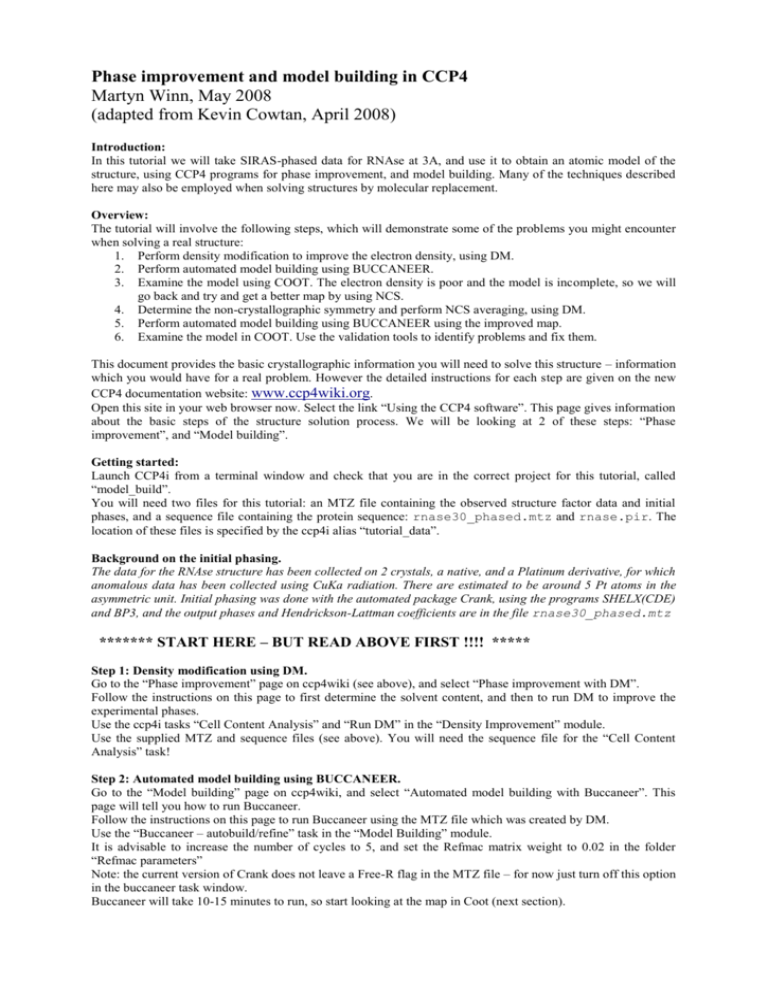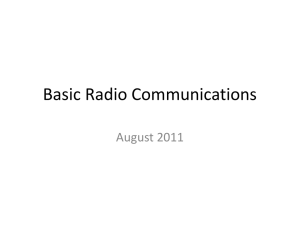Buccaneer tutorial
advertisement

Phase improvement and model building in CCP4 Martyn Winn, May 2008 (adapted from Kevin Cowtan, April 2008) Introduction: In this tutorial we will take SIRAS-phased data for RNAse at 3A, and use it to obtain an atomic model of the structure, using CCP4 programs for phase improvement, and model building. Many of the techniques described here may also be employed when solving structures by molecular replacement. Overview: The tutorial will involve the following steps, which will demonstrate some of the problems you might encounter when solving a real structure: 1. Perform density modification to improve the electron density, using DM. 2. Perform automated model building using BUCCANEER. 3. Examine the model using COOT. The electron density is poor and the model is incomplete, so we will go back and try and get a better map by using NCS. 4. Determine the non-crystallographic symmetry and perform NCS averaging, using DM. 5. Perform automated model building using BUCCANEER using the improved map. 6. Examine the model in COOT. Use the validation tools to identify problems and fix them. This document provides the basic crystallographic information you will need to solve this structure – information which you would have for a real problem. However the detailed instructions for each step are given on the new CCP4 documentation website: www.ccp4wiki.org. Open this site in your web browser now. Select the link “Using the CCP4 software”. This page gives information about the basic steps of the structure solution process. We will be looking at 2 of these steps: “Phase improvement”, and “Model building”. Getting started: Launch CCP4i from a terminal window and check that you are in the correct project for this tutorial, called “model_build”. You will need two files for this tutorial: an MTZ file containing the observed structure factor data and initial phases, and a sequence file containing the protein sequence: rnase30_phased.mtz and rnase.pir. The location of these files is specified by the ccp4i alias “tutorial_data”. Background on the initial phasing. The data for the RNAse structure has been collected on 2 crystals, a native, and a Platinum derivative, for which anomalous data has been collected using CuKa radiation. There are estimated to be around 5 Pt atoms in the asymmetric unit. Initial phasing was done with the automated package Crank, using the programs SHELX(CDE) and BP3, and the output phases and Hendrickson-Lattman coefficients are in the file rnase30_phased.mtz ******* START HERE – BUT READ ABOVE FIRST !!!! ***** Step 1: Density modification using DM. Go to the “Phase improvement” page on ccp4wiki (see above), and select “Phase improvement with DM”. Follow the instructions on this page to first determine the solvent content, and then to run DM to improve the experimental phases. Use the ccp4i tasks “Cell Content Analysis” and “Run DM” in the “Density Improvement” module. Use the supplied MTZ and sequence files (see above). You will need the sequence file for the “Cell Content Analysis” task! Step 2: Automated model building using BUCCANEER. Go to the “Model building” page on ccp4wiki, and select “Automated model building with Buccaneer”. This page will tell you how to run Buccaneer. Follow the instructions on this page to run Buccaneer using the MTZ file which was created by DM. Use the “Buccaneer – autobuild/refine” task in the “Model Building” module. It is advisable to increase the number of cycles to 5, and set the Refmac matrix weight to 0.02 in the folder “Refmac parameters” Note: the current version of Crank does not leave a Free-R flag in the MTZ file – for now just turn off this option in the buccaneer task window. Buccaneer will take 10-15 minutes to run, so start looking at the map in Coot (next section). Step 3: Examine the model using COOT. Launch Coot and read in the MTZ file from DM, using the columns FDM and PHIDM, and get an idea of the quality of the map. The columns 5_BP3_F and 5_BP3_PHIB are for the initial phases before DM. When Buccaneer has finished (previous section), read in the model produced. Look at the chains in the model using the “Draw/Sequence View” or “Draw/Go to atom” tool. The chain trace is broken into several chain fragments, and some chains are unsequenced (UNK). The cell content analysis indicated 2 mols/ASU. You may now be able to identify NCS from the partial model. From the sequence in the “Draw/Sequence View” you may find some sections of sequence which have been built more than once. Or you may be able to identify related chains by shape, by viewing the Ca-trace. Make a note of the chain Ids and the range of overlapped sequence numbers (excluding UNKs unless the conformations look similar). Step 4: NCS averaging using DM. Go to the “Phase improvement” page on ccp4wiki, and select “Phase improvement by NCS averaging with DM”. Follow the instructions in the section “Determining the NCS operators using a partial model” to determine an NCS operator using the duplicated residue ranges you found in Coot (previous section). Use the task “Superpose Molecules” in the “Coordinate Utilities” module. Check the RMS difference between the superposed chains is reasonable (<1.5A). If you were unable to identify the NCS, the correct operators are in the file NCS_operators in the “tutorial_data” directory. In the CCP4i task list, select your previous DM job, and then click “Rerun job” from the right-mouse context menu. Set up an averaging calculation using the NCS operator you determined previously. Give the output MTZ file a new name. Run the job and examine the output carefully. Follow the instructions in the section “Program output” to determine if the NCS calculation has worked. Step 5: Automated model building using BUCCANEER. In the CCP4i task list, select your previous buccaneer job, and then click “Rerun job” from the right-mouse context menu. Change the input MTZ file to the one you created with your DM averaging job and run it. It is again advisable to increase the number of cycles to 5, and set the Refmac matrix weight to 0.02. Compare the output log file, and in particular the summary sections, to see if the results have improved. While Buccaneer is running, compare the un-averaged and averaged maps in Coot. Step 6: Complete the model in COOT. Launch Coot and read in the model from Buccaneer. Read in the MTZ file from DM and get an idea of the quality of the map. Use the “Model/fit/refine” tools to correct any breaks in the chain. Use the “Validate” tools to identify any problems in the model and correct them. Add waters to the model. Re-refine your model in Refmac.







